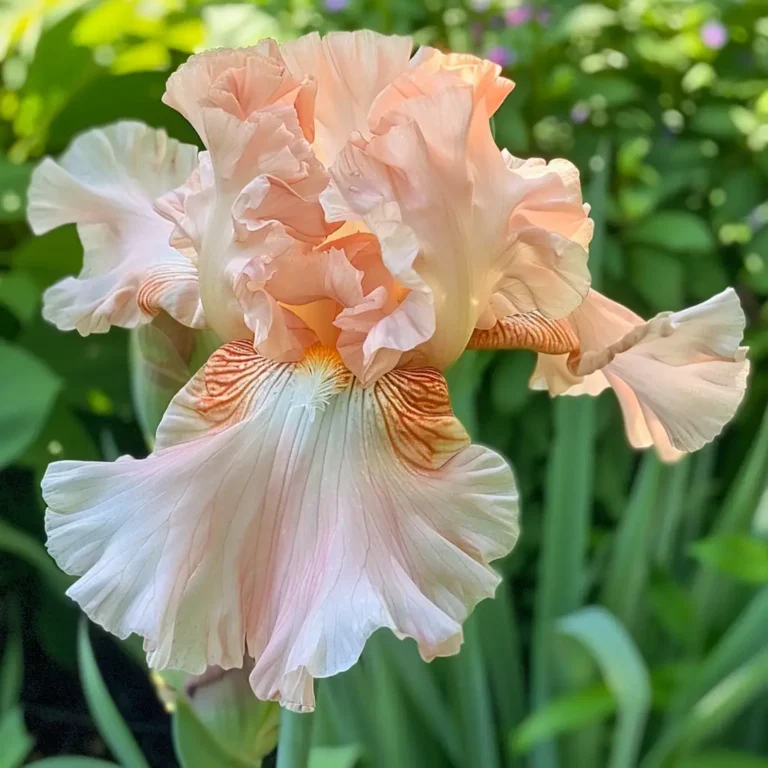Introduction
The Peach Parfait Iris is a stunning flower that has captivated gardeners and flower enthusiasts for decades. Known for its tall bearded appearance and delicate peach-colored blooms, this iris variety offers a unique charm to any garden. In this article, we will delve into the historical background, characteristics, growing conditions, landscaping uses, care, and cultural significance of the Peach Parfait Iris. We will also answer some frequently asked questions about this beautiful plant.
Historical Background of Peach Parfait Iris
Origin and Breeding History
The Peach Parfait Iris was first introduced in 1948 by renowned breeder Tom Craig. This variety quickly gained popularity due to its striking appearance and robust growth. Over the years, other breeders have contributed to its development, enhancing its features and adapting it to different growing conditions.
Key Breeders and Their Contributions
Tom Craig’s initial work laid the foundation for the Peach Parfait Iris. Subsequent breeders, such as Larry Lauer, have continued to refine the plant, introducing variations like the Butterscotch Peach Parfait. These efforts have ensured that the Peach Parfait Iris remains a favorite among gardeners.
Classification and Characteristics of Peach Parfait Iris
Classification: Tall Bearded Iris
The Peach Parfait Iris belongs to the Tall Bearded Iris category, known for its height and showy blooms. This classification makes it an excellent choice for adding vertical interest to garden landscapes.
Description: Color, Shape, Size
- Color: The Peach Parfait Iris features soft peach hues with ruffled petals that create a delicate and elegant look.
- Shape: The flowers have a classic iris shape, with three upright petals (standards) and three hanging petals (falls).
- Size: These irises typically reach a height of 38 inches (97 cm), making them a prominent feature in any garden.
Bloom Season and Flowering Period
The Peach Parfait Iris blooms in the mid-season, providing a burst of color when many other plants are still growing. This bloom period typically lasts for several weeks, allowing ample time to enjoy its beauty.
Growing Conditions and Cultivation Techniques
Soil Requirements
- Ideal Soil: The Peach Parfait Iris thrives in well-drained soil with a slightly acidic to neutral pH.
- Preparation: Before planting, ensure the soil is loose and enriched with organic matter.
Light Needs
- Peach Parfait Iris requires full sun to partial shade. At least 6 hours of direct sunlight daily is ideal for optimal growth and bloom.
Watering Needs
- Frequency: Water regularly during the growing season, ensuring the soil remains moist but not waterlogged.
- Method: Avoid overhead watering to prevent fungal diseases; instead, water at the base of the plant.
Fertilization
- Type: Use a balanced fertilizer, such as a 10-10-10 NPK formula.
- Schedule: Fertilize in early spring before new growth starts and again after the bloom period.
Pest Control
- Common Pests: Monitor for pests such as aphids and iris borers.
- Management: Use insecticidal soap or neem oil for pest control and practice good garden hygiene.
Propagation Methods
- Division: The most common method of propagating Peach Parfait Iris is through division. This should be done every 3-4 years to maintain plant health and vigor.
Landscaping Uses and Design Tips
Ideal Garden Settings
- Garden Beds: Peach Parfait Iris works well in perennial borders and mixed garden beds.
- Containers: These irises can also be grown in large containers, making them versatile for different garden styles.
Companion Plants
- Plants: Consider planting with other perennials like peonies, daylilies, and ornamental grasses to create a dynamic and colorful garden.
Seasonal Interest
- Early Season: Pair with early-blooming bulbs like tulips and daffodils.
- Late Season: Combine with late-blooming flowers such as asters and chrysanthemums to extend garden interest.
Care and Maintenance
Pruning and Deadheading
- Pruning: Remove spent blooms to encourage further flowering and maintain plant health.
- Deadheading: Regular deadheading prevents the plant from expending energy on seed production.
Winter Care
- Protection: In colder climates, mulch around the base of the plants to protect the rhizomes from freezing temperatures.
Common Issues
- Diseases: Watch for signs of fungal diseases like leaf spot and root rot.
- Solutions: Ensure good air circulation and avoid overwatering to prevent these issues.
Peach Parfait Iris in Art and Culture
Artistic Representation
The Peach Parfait Iris has been a source of inspiration for artists, such as Lisa Hill, who captures its beauty in her realistic watercolor paintings.
Cultural Significance
In various cultures, irises symbolize hope, valor, and wisdom. The Peach Parfait Iris, with its unique color and form, adds a layer of elegance to these traditional meanings.
FAQs
How tall does Peach Parfait Iris grow?
The Peach Parfait Iris typically grows to a height of 38 inches (97 cm).
When is the best time to plant Peach Parfait Iris?
The best time to plant Peach Parfait Iris is in late summer to early fall, allowing the roots to establish before winter.
How to propagate Peach Parfait Iris?
The most effective way to propagate Peach Parfait Iris is through division, which should be done every 3-4 years.
Conclusion
The Peach Parfait Iris is a versatile and beautiful addition to any garden. With proper care and maintenance, this tall bearded iris will provide stunning blooms year after year. Whether you are an experienced gardener or a beginner, the Peach Parfait Iris is sure to bring joy and elegance to your outdoor space.

